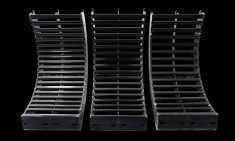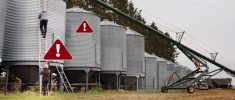Every year, several Canadian farmers and workers suffocate in grain bins.
These deaths are preventable. People can become caught or trapped in grain bins in three different ways:
Read Also

Local farm businesses, groups look forward to Manitoba Ag Days 2026
Most of agriculture is seemingly at Manitoba Ag Days each January: Manitoba agribusinesses and farm groups look forward to connecting with farmers at the 2026 show.
- collapse of bridged grain;
- collapse of a vertical wall of grain; and
- engulfment in grain.
Moving or flowing grain is involved in all three. When working with grain – loading it, unloading it and moving it from bin to bin – farmers should be aware of the hazards and know how to prevent injury.
Background
Farmers and workers enter grain bins for several reasons, such as to monitor the grain condition, break a crusted layer or check the grain or bin during loading or unloading. Also, children may enter a bin or wagon to play.
With bottom-unloaded bins, the inlet for the unloading auger is at the centre of the bin floor. During unloading, a vertical column of grain flow forms a funnel-shaped path directly over the inlet when the auger is running.
When an object like a shovel or a person gets in this flowing path, it is rapidly pulled down with the grain. It takes only a few seconds to be knee-deep, only about five seconds to be unable to break free and only a few more seconds to be completely engulfed.
Once the grain is waist level or higher, a person cannot be pulled from flowing grain without risk of injury to their spinal column.
Entry procedure
More detailed entry procedures available, but a few key points can improve safety:
- Don’t enter a grain bin unless you have a plan.
- Make sure children know the grain bin is off-limits.
- If you must enter a grain bin, have at least two people nearby prepared and capable of helping in an emergency.
- Use extreme caution if entering a bin containing wet, mouldy or spoiled grain. Air hazards may include toxic gases, dust and reduced oxygen content. Turn on the blower and use respiratory protective equipment in such situations.
- Lock out the power source to the auger, ensuring no one can start filling or emptying the bin while you are inside.
- If there is a permanent ladder on the inside of the bin, stay on the ladder above the level of compacted or bridged grain while dislodging the grain. Wear a full-body harness with the lanyard attached to the ladder above your head. If you are in a bin that doesn’t have a permanent ladder, use a safety harness with rope and secure it to a point outside the bin.
Emergency procedures
Plan for escape before entering. Always have a person watch from the outside.
The watcher should have clear instructions on what to do in an emergency. The first instruction must be “don’t follow me in,” followed by “call 911 and get help here if I get trapped.”
If you are in a bin without a ladder and the grain starts to flow, try to reach the bin wall and keep walking around the bin next to the wall. Remember, grain moves slowest along the wall and fastest at the centre.
If trapped by grain do not panic or the grain will pack tighter. Shield your face and chest with arms and clothing to create space for breathing.
If someone is trapped in a grain bin, empty it by opening any side outlets, or cut flaps in the walls all around the base of the bin using power tools. This way, the grain will flow outward and away from the victim, rather than using the unloading auger, which will continue the downward funnel-like suction.















